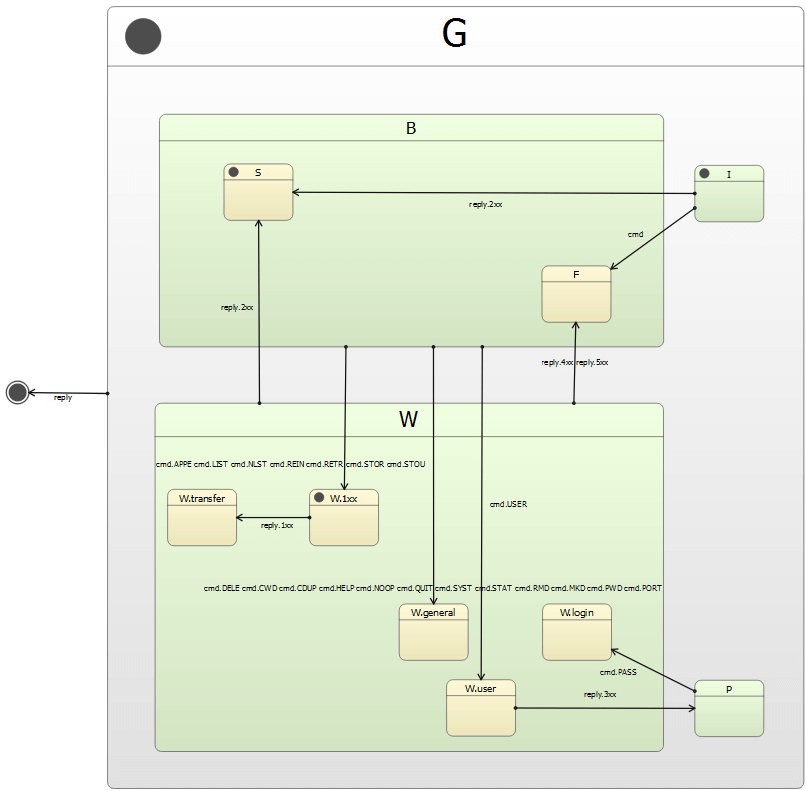使用状态机实现简单 FTP 客户端。
FTP 客户端 uses Qt SCXML to implement a FTP client that can communicate with a FTP service by sending FTP control messages translated from state machine events and by translating server replies into state machine events. The data received from the FTP server is printed on the console.
RFC 959 specifies state charts for the command handling of the FTP client. They can be easily translated into SCXML to benefit from SCXML nested states. Connections between the client and server and data transfer are implemented by using C++. In addition, Qt signals and slots are used.
状态机拥有以下状态:

The state machine is specified in the
simpleftp.scxml
file and compiled into the
FtpClient
class that implements the logic of the FTP protocol. It reacts to user input and to replies from the control channel by changing states and sending external events. In addition, we implement a
FtpControlChannel
class and a
FtpDataChannel
class that handle TCP sockets and servers and convert line endings.
要运行范例从 Qt Creator ,打开 Welcome 模式,然后选择范例从 Examples 。更多信息,拜访 构建和运行范例 .
We link against the Qt SCXML module by adding the following line to the project build files.
With qmake, we add the following to ftpclient.pro
QT = core scxml network
接着,指定要编译的状态机:
STATECHARTS += simpleftp.scxml
With CMake, we add the following to CMakeLists.txt
find_package(Qt6 REQUIRED COMPONENTS Core Network Scxml)
target_link_libraries(ftpclient PRIVATE
Qt6::Core
Qt6::Network
Qt6::Scxml
)
接着,指定要编译的状态机:
qt6_add_statecharts(ftpclient
simpleftp.scxml
)
Qt SCXML 编译器
qscxmlc
, is run automatically to generate
simpleftp.h
and
simpleftp.cpp
, and to add them appropriately to the project as headers and sources.
We instantiate the generated
FtpClient
class, as well as the
FtpDataChannel
and
FtpControlChannel
类在
main.cpp
文件:
#include "ftpcontrolchannel.h" #include "ftpdatachannel.h" #include "simpleftp.h" ... int main(int argc, char *argv[]) { ... QCoreApplication app(argc, argv); FtpClient ftpClient; FtpDataChannel dataChannel; FtpControlChannel controlChannel; ...
We print all data retrieved from the server on the console:
QObject::connect(&dataChannel, &FtpDataChannel::dataReceived,
[](const QByteArray &data) {
std::cout << data.constData() << std::flush;
});
We translate server replies into state machine events:
QObject::connect(&controlChannel, &FtpControlChannel::reply, &ftpClient,
[&ftpClient](int code, const QString ¶meters) {
ftpClient.submitEvent(QString("reply.%1xx")
.arg(code / 100), parameters);
});
We translate commands from the state machine into FTP control messages:
ftpClient.connectToEvent("submit.cmd", &controlChannel,
[&controlChannel](const QScxmlEvent &event) {
controlChannel.command(event.name().mid(11).toUtf8(),
event.data().toMap()["params"].toByteArray());
});
We send commands to log into the FTP server as an anonymous user, to announce a port for the data connection, and to retrieve a file:
QList<Command> commands({
{"cmd.USER", "anonymous"},// login
{"cmd.PORT", ""}, // announce port for data connection,
// args added below.
{"cmd.RETR", file} // retrieve a file
});
We specify that the FTP client should send the next command when entering the B state:
ftpClient.connectToState("B", QScxmlStateMachine::onEntry([&]() {
if (commands.isEmpty()) {
app.quit();
return;
}
Command command = commands.takeFirst();
qDebug() << "Posting command" << command.cmd << command.args;
ftpClient.submitEvent(command.cmd, command.args);
}));
We specify that the FTP client should send an empty string as a password if the server asks for one:
ftpClient.connectToState("P", QScxmlStateMachine::onEntry([&ftpClient]() {
qDebug() << "Sending password";
ftpClient.submitEvent("cmd.PASS", QString());
}));
Finally, we connect to the FTP server specified as the first argument of the method and retrieve the file specified as the second argument:
controlChannel.connectToServer(server);
QObject::connect(&controlChannel, &FtpControlChannel::opened, &dataChannel,
[&](const QHostAddress &address, int) {
dataChannel.listen(address);
commands[1].args = dataChannel.portspec();
ftpClient.start();
});
For example, the following invocation prints the specified file from the specified server:
ftpclient <server> <file>
.